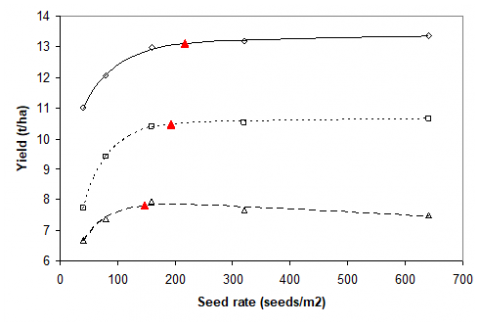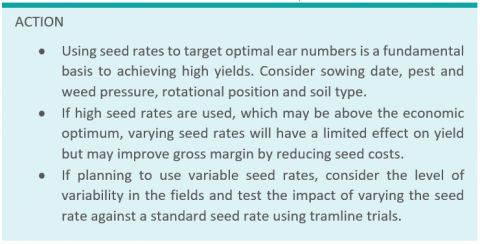Susie Roques
Crop Action Article - Planning for drilling 2024 cereal crops
Most wheat crops require at least 400 ears/m2 to reach their yield potential, and analysis of the Cereal YEN database has shown that for crops expected to exceed 11 t/ha, a higher target final ear number of 600 ears/m2 is required. To reliably achieve these target ear numbers, it is necessary to produce more shoots by the start of stem extension because some will be lost before harvest. However, the seed rates required can be surprisingly low, due to the capacity of wheat for compensatory tillering.
Sub-optimal seed rates result in low yields while super-optimal seed rates raise input costs and increase the risk of lodging, which can reduce yield by up to 50%. Seed rate response trials in several past projects have shown that optimum seed rates for cereals are typically less than 200 seeds/m2, but commercial seed rates are usually over 300 seeds/m2. However, it is rational to opt for seed rate slightly higher than the expected optimum as an insurance against poor or variable establishment, because yield and gross margin drop off a lot more rapidly with sub-optimal than super-optimal seed rates (Figure 1).

Factors to consider when choosing a seed rate include:
- Weed pressure: a high seed rate will be more competitive in a high weed pressure situation.
- Drilling date: establishment is typically around 70% for September-drilled crops, falling to 50% for November sowings.
- Soil texture: average establishment rates on loams and clays are around 65%, compared to 90% on sandy soils, hence higher seed rates are required for heavier soils.
- Predation: higher seed rates may be required on headlands known to suffer from grazing.
Variable seed rates
Most fields show substantial variation in seed germination or establishment rates due to variation in soil type, weed pressures, soil moisture and predation. It follows that the optimal seed rate for yield will also vary, hence the prevalence of services offering variable rate seed maps. These are usually based on soil conductivity maps or satellite soil brightness maps, with higher seed rates used in parts of a field where heavier soil is expected to lead to lower establishment.
Unfortunately, across more than 20 variable seed rate trials run by ADAS, only one has shown significant yield benefits of variable seeding compared to flat rate. Significant gross margin benefits occurred slightly more often, in situations where the ‘farm standard’ flat seed rate was super-optimal, and the variable rate saved on seed costs without loss of yield. However, these gross margin calculations don’t include technology or service costs to obtain the variable seed rate maps, so it is likely that the overall benefits from variable seed rate technologies are marginal.

